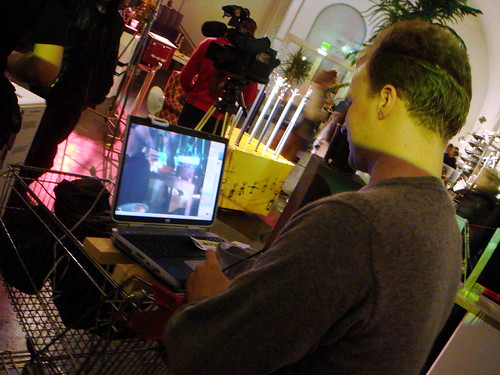Laptop + shopping cart = mobile
This guy can roll up with laptop and webcam to record robots (photo CC from violetblue):
But in Silicon Valley, combining laptops and shopping carts is just a way to get chores done. When at Whole Foods in Los Altos, I saw a man pushing a shopping cart with a laptop in the part where you can sit your toddler. I suppose he was reading a recipe or something. (I, and I’m sure other Valley folks, do that on a phone.)
A bit odd, but then again, I used to be (I’ve fallen off a bit) judicious about capturing the contents of my shopping cart with ZoneTag.
Texting 4 Health conference in review
As I blogged already, I attended and spoke at the first Texting 4 Health conference at Stanford University last week. You can see my presentation slides at SlideShare here, and the program, with links to the slides for most speakers is here.
The conference was very interesting, and there was quite the mix of participants — both speakers and others. There were medical school faculty, business people, people from NGOs and foundations, technologists, representatives of government agencies and centers, futurists, and social scientists. Everyone had something to learn — I know I did. This also made it somewhat difficult as a speaker because it is hard to know how best to reach, inform, and hold the interest of such a diverse audience: what is common ground with some is entirely new territory with others.
I think my favorite session was “Changing Health Behavior via SMS”. The methods used by the panelists to evaluate their interventions were both interesting to reflect on and good tools for persuading me of the importance and effectiveness of their work. One of my reflections was about what factors to vary in doing experiments on health interventions: there is (reasonable) focus on having a no-SMS control condition, and there are very few studies with manipulations of dimensions more fine-grained. Of course, the field is young and I understand how important true controls are in medical domains, but I think that real progress in understanding mobile messaging and designing effective interventions will require looking at more subtle and theoretically valuable manipulations.
You can see other posts about the conference here and here. And the conference Web site is also starting a blog to watch in the future.
Texting 4 Health
On February 29th I’m speaking at Texting 4 Health, a conference at Stanford University about using mobile messaging for health interventions and research. I’ll be talking about mobile messaging research methods I’ve used to study mobile persuasive technology. Like Mobile Persuasion 2007, it will feature a fast-paced, single-track program with time to meet and talk with participants from health, technology, policy, and research communities.
Advanced Soldier Sensor Information System and Technology
Yes, that spells ASSIST.
Check out this call for proposals from DARPA (also see Wired News). This research program is designed to create and evaluate systems that use sensors to capture soldiers’ experiences in the field, thus allowing for (spatially and temporally) distant review and analysis of this data, as well as augmenting their abilities while still in the field.
I found it interesting to consider differences in requirements between this program and others that would apply some similar technologies and involve similar interactions — but for other purposes. For example, two such uses are (1) everyday life recording for social sharing and memory and (2) rich data collection as part of ethnographic observation and participation.
When doing some observation myself, I strung my cameraphone around my neck and used Waymarkr to automatically capture a photo every minute or so. Check out the results from my visit to a flea market in San Francisco.


Photos of two ways to wear a cameraphone from Waymarkr. Incidentally, Waymarkr uses the cell-tower-based location API created for ZoneTag, a project I worked on at Yahoo! Research Berkeley.
Also, for a use more like (1) in a fashion context, see Blogging in Motion. This project (for Yahoo! Hack Day) created a “auto-blogging purse” that captures photos (again using ZoneTag) whenever the wearer moves around (sensed using GPS).
Taxonomy of diary research methods
Diary studies are widely used in human-computer interaction research, but also in user experience research as practiced in product R&D groups. Bolger, Davis, & Rafaeli (2003) is a good review of diary research methods from a Psychology perspective. It gives practical guidance in what research questions are suited to these methods, design decisions, tools, and analysis.
Though it covers state-of-the-art technology used for these methods, I think the argument below for the taxonomy of methods used in this paper needs revision in light of new diary methods, e.g. those made possible by using context-aware devices for signaling participants. Here is the argument for the two-way taxonomy (p. 588):
Diary studies have often been classified into the three categories of interval-, signal-, and event-contingent protocols (e.g., Wheeler & Reis 1991). The interval-contingent design, the oldest method of daily event recording, requires participants to report on their experiences at regular, predetermined intervals. Signal-contingent designs rely on some signaling device to prompt participants to provide diary reports at fixed, random, or a combination of fixed and random intervals. Event-contingent studies, arguably the most distinct design strategy, require participants to provide a self-report each time the event in question occurs. This design enables the assessment of rare or specialized occurrences that would not necessarily be captured by fixed or random interval assessments.
As we see it, diary studies serve one of two major purposes: the investigation of phenomena as they unfold over time, or the focused examination of specific, and often rare, phenomena. It appears to us that the three-way classification blends this conceptual distinction with the technological issue of signaling. Instead, we incorporate interval- and signal-contingent designs into a single category, which we call time-based designs.
This argument to collapse the taxonomy does not account for methods in which participants are signaled based on factors other than time. For example, diary studies can include signaling participants to create an entry based on events that are automatically detected by the system: this occurs when the system is immediately aware of the event because it is an interaction with the system (e.g. the participant has just completed a phone call) or because it can infer an appropriate change in state (e.g. the participant has just moved from one place to another, as detected by readings from GPS).

